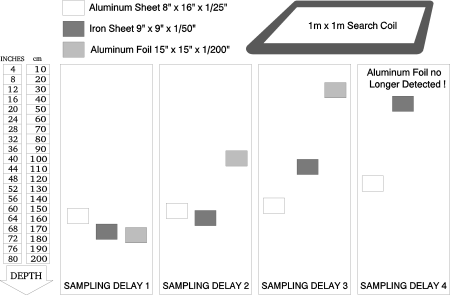
| 3 Detection Depths |
|
|
When verifying detection depths reached with the PULSE STAR II, you can use the examples below which have been tested as references. These objects are easily available for confirming the depth capabilities of your PULSE STAR II metal detector. The conditions while testing and recording the below objects were as follows: The MODE switch was in NORMAL position, SAMPLING DELAY was in position 1 and a one meter by one meter coil was used. A clear increase of the ticking-noise and a clear meter reading had to be noticed. The largest surface of each object was measured.
| Object | Detection Range in Inches (Air Tested) |
| Soft Drink Can (0.33 l) | approx. 40 |
| Aluminum Sheet 8" x 16" x 1/25" | approx. 65 |
| Iron Sheet 9" x 9" x 1/50" | approx. 70 |
| Fuel Tank 20 Liters (Iron) | approx. 88 |
These depths can be far exceeded when detecting larger objects.
From the diagram "Reaction of SAMPLING DELAY" on the next page you will notice the discrimination capability of the PULSE STAR II. Three different kinds of metal objects were used as examples to show how they are detected at different SAMPLING DELAY positions.
It is interesting to note that with the SAMPLING DELAY control knob at position 1 or 2 the iron sheet can be detected at very good depth, while at position 3 or 4 a clear drop is shown. Many metal container lids and other small objects (made of aluminum or lead alloys) as well as even large aluminum foils can be completely rejected at these positions.
With objects made of (highly) conductive non-ferrous metals like copper and especially precious metals like gold or silver, you will lose much less detection depth (depending on size of object). The reason for this is that the decay of the eddy currents in these metals takes a lot more time. So if you are looking for large non-ferrous objects (especially precious metals) in an area which is scattered with small pieces of trash, it is advisable to operate in SAMPLING DELAY positions 3 or 4. But remember that the sensitivity to the wanted object may be reduced as well, depending on its size, shape, and conductivity (which can be clearly lower with alloys than with pure metals !).
All mentioned detection depths may differ either positively or negatively when using reference objects of the same size, but possibly made of different alloys.
Note: Detection depths for accessory coils can be found in chapter 8 (Accessories).
 |
| Fig. 6: Reaction of SAMPLING DELAY |
| This diagramm shows how three different kinds of objects are detected with changing SAMPLING DELAY positions. The one meter search coil was used facing the largest surface part of the objects in NORMAL search mode. A clear increase of the ticking-noise and a clear meter reading had to be observed for proof of position of object. |
| Chapter 2 | Chapter 4 |